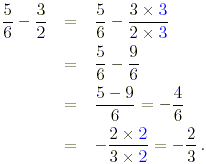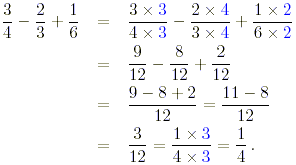Adding and Substracting Fractions
In this section we look at the addition (and subtraction) of
fractions. If fractions are to be added then they must have the
same denominators .
Example
Write the following sums of fractions as single fractions.

Solution
a) Taking all the fractions with denominator 24,

(b) This time, taking all the fractions with denominator 12,

The exercise below is designed to give you some practice at
addition and subtraction of fractions.
Exercise
Evaluate the following, putting the final answer in its lowest
terms.

(a) The lowest common denominator is 24, so

(b) Before proceeding, note that the second fraction is not in
its lowest terms. Since 2/4=(1 × 2 )/(2 × 2 )=1/2,

This fraction is called an improper fraction since the
numerator is larger than the denominator. It is perfectly
acceptable as a fraction but it may also written as  . .
(c) The least common denominator of the two fractions is 20 so

This is another improper fraction which may be written as 
(d) The least common denominator of the two fractions is 12 so

This is another improper fraction which is equal to 
(e) The least common denominator of the two fractions is 6 so

where the common factor 2 has been cancelled to obtain the
final answer.
(f) The least common denominator of the two fractions is 30 so

where the final answer is obtained after cancellation of the
common factor 2.
To finish this section there follows two simple quizzes.
Quiz
Which of the following fractions is the result of evaluating
the sum 3 4 - 2 3 + 1 6 ?
(a) 1/4, (b) 1/3, (c) 1/5, (d) 3/8.
Solution
The least common denominator of the three fractions is 12, so

Quiz
From the fraction given below, choose the one which is mid-way
between 2/3 and 4/5.
(a) 2/3, (b) 3/5, (c) 10/15 (d) 11/15.
Solution
The least common denominator of the two fractions is 15.
Writing both fractions with this denominator gives

The fraction mid-way between 10/15 and 12/15 is 11/15.
|